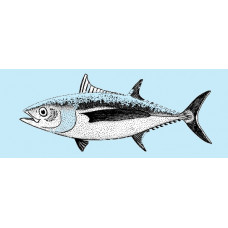Latin name
Thunnus alalunga
Other names
Longfin tuna, long-finned tunny, longfin, true albacore, albacore tuna, albie, and pigfish; French: germon; Hawaiian: áhi pahala; Japanese: binchô, binnaga; Portuguese: albacora; Spanish: albacora, atún blanco.
Identification
The albacore has long pectoral fins that reach a point behind the anal fin, as well as small fins on the back and belly that extend from the anal fin to the tail. The body height is about 3.7-4.1 times SL, with the greatest height being near the middle of the dorsal fin or slightly behind it. The head is conical, stacked about 3-3.5 times the body length. The teeth on the jaws and cuspidor are small and conical. The diameter of the eye is stacked about 5.5 times the length of the head. The caudal peduncle is slender, with a strong lateral keel and additional weak keels above and below it. The pectoral fins reach the caudal peduncle or extend beyond the vertical base of the anal fin. The swim bladder is present. The lower surface of the liver with radial striations. Albacore coloration is dark blue, turning into greenish-blue near the tail and silvery-white on the belly. A metallic or iridescent cast covers the entire body. The dorsal fins are yellowish, except for the white edge of the tail, and the anal fins are silvery or dusky.
Distribution
Occurs in all oceans. Distributed worldwide in tropical and temperate seas, including the Mediterranean, it also makes seasonal migrations to colder areas such as New England, southern Brazil and the northern Gulf of Mexico. In the western Atlantic Ocean, albacore are found from Nova Scotia to Brazil, although they rarely go north of New York City and are absent from the Straits of Florida; in the Pacific, they are found from Alaska to Mexico. The albacore is more abundant in the Pacific, but less common in the Atlantic.
Habitat
Albacore prefers tropical, subtropical and temperate waters with temperatures ranging from 60° to 66°. These fish rarely come close to shore and prefer deep, wide-open waters.
Size
The average weight of Albacore ranges from 10 to 25 pounds. The record weight for all tackle is 88 pounds, 2 ounces, although fish caught on an industrial scale have weighed up to 93 pounds. Albacore can grow up to 5 feet in length. The young are growing very fast, and the growth rate decreases.
Life history and Behavior
Albacore is migratory and pelagic; it lives and feeds in the open sea. It performs long migrations. Seasonal migrations are mainly along the coast. Albacore is one of the the fastest migrating fish in the world, and tagging studies have tracked their movements across the ocean. Albacore spawn from July through October along the west coast of North America, and in summer in the Southern Hemisphere of the mid-Pacific.
Food and feeding habits
Predator. The food spectrum includes: anchovies, horse mackerel, herring, shiner anchovies, saury, small species of perch, as well as squid and large species of euphausiids. It feeds both during the day and at night. Usually feeds near the surface, but can also feed in mid-depths.
Reproduction
Spawning occurs in areas of subtropical convergence in a relatively short period: near the Hawaiian Islands in May-June, in the Coral Sea and New Caledonia in September-March, near California from January to July, the peak of spawning in April. Fertility up to 3.6 million eggs. The eggs are pelagic, globular, and have a fat blob.
Interesting facts
Albacore tuna is sometimes called 'sea chicken'. It is fished off the western coast of Africa. It is caught using long lines or a fishing rod with a sardine on the hook. They can also be caught by trolling with a rubber squid or an artificial fish with a feather-disguised hook as bait.
| Classification | |
| Phylum | Chordata |
| Class | Actinopterygii |
| Family | Scombridae |
| Genus | Thunnus |
| Species | T. alalunga |
| Features | |
| Conservation status | Least Concern |
| Habitat | Pelagic |
| Life span, years | 12 |
| Maximum body weight, kg | 5 |
| Maximum length, cm | 140 |
| Sailing speed, m/s | No information |
| Threat to people | Edible |
| Way of eating | Predator |
Albacore
Tags: Albacore




